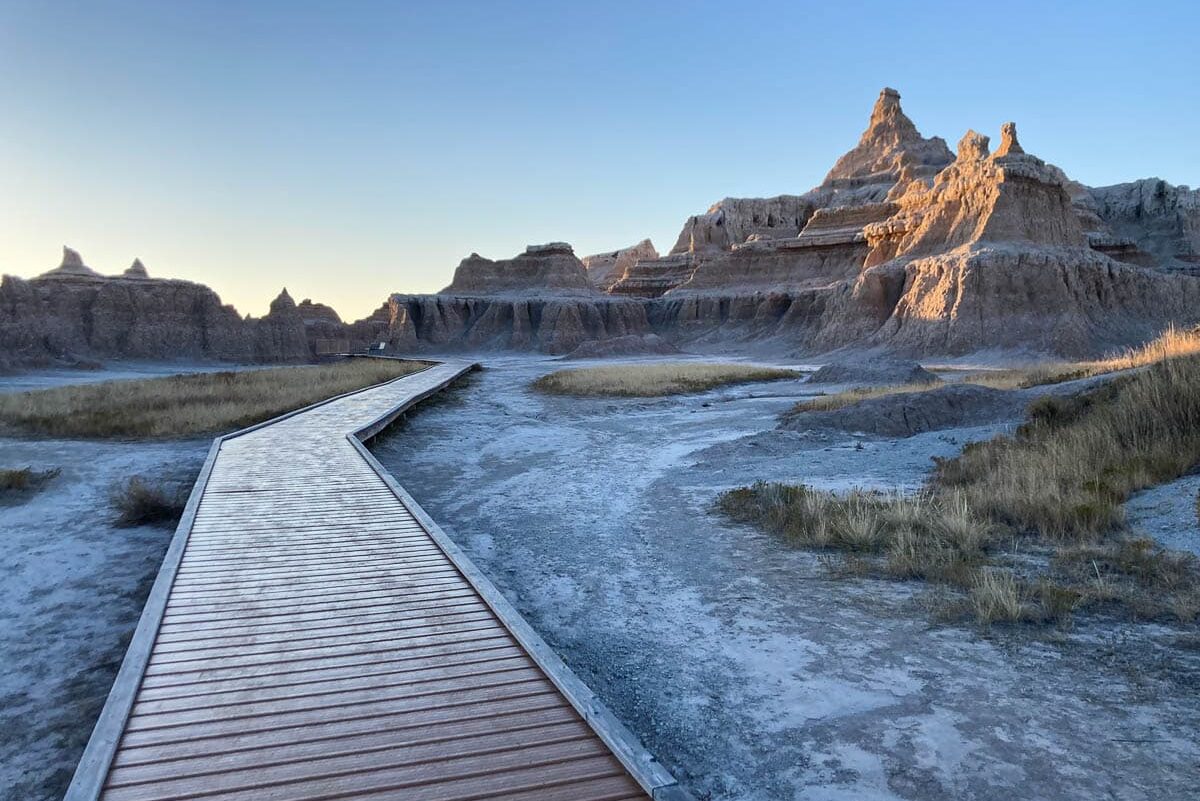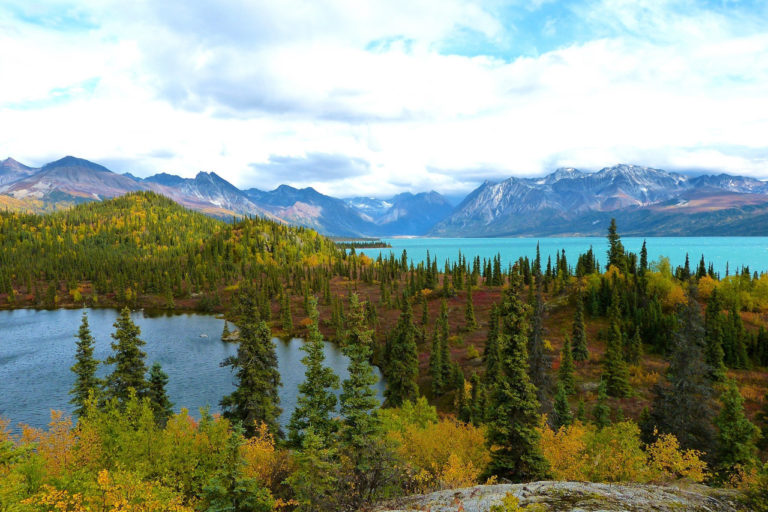10 Amazing Hikes in Badlands National Park
While the otherworldly landscapes of the South Dakota Badlands used to deter early fur trappers and pioneers, they now attract casual hikers and experienced backpackers alike. Compared to most U.S. national parks, there are relatively few hiking trails in Badlands National Park, but they do offer an amazing, immersive hiking experience.
The Badlands National Park hikes range from very short strolls on boardwalks to multi-mile backcountry explorations.
The majority of trails in the Badlands, however, are on the shorter side, not exceeding 1.5 miles in length. Some are wheelchair accessible as well.
Below, you’ll find the best hikes in Badlands National Park. They provide an insight in the area’s fascinating geological record, numerous paleontological highlights and rich human history.
These trails also offer a memorable immersion in the rugged Badlands scenery, along with great wildlife viewing opportunities. The quintessential Badlands experience, in other words.
This blog post about the best hikes in Badlands National Park contains affiliate links. You can read more about our Terms of Use / Disclosure here.

Badlands National Park Hiking Tips
Open Hike Policy
What makes Badlands National Park such a great hiking destination is its so-called “open hike policy.” This means that you are allowed to leave the trails and, essentially, wander around as you please.
Visitors are “free to explore social trails like Deer Haven, the Sage Creek Wilderness Area or any other part of the park you can visit safely,” the National Park Service says.
As such, you can climb Badlands formations, follow game trails into the backcountry and meander through the prairie grasslands as far and as long as you want.
When enjoying the open hike policy in Badlands National Park, it’s important to be careful and cautious, though. The weather can change suddenly, dangerous wildlife abounds and cell service is usually not available in the backcountry.
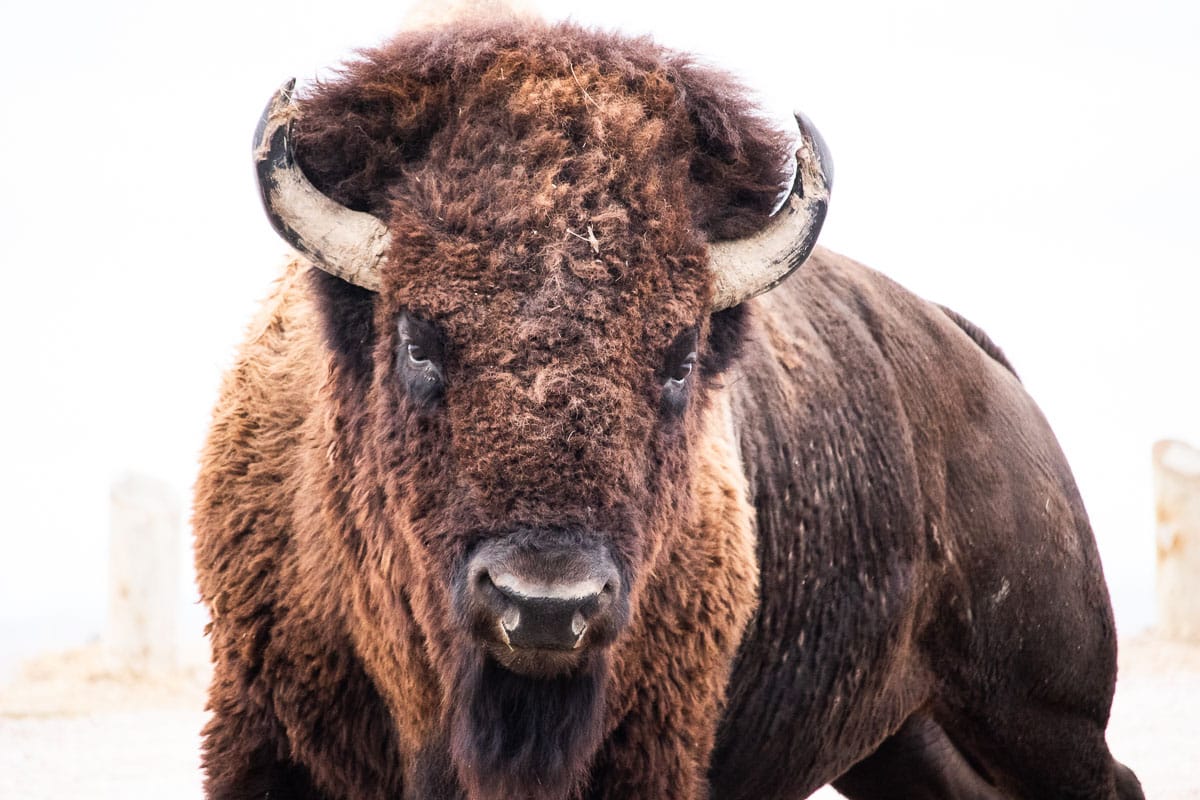
Wildlife Safety
You don’t have to hike deep into the wilderness to see or encounter wildlife in Badlands National Park. Even on popular Badlands hikes it’s possible to come across wildlife, which warrants caution.
Prairie rattlesnakes are present throughout the park—and ubiquitous warning signs will remind you of that fact—while large animals like bison, bighorn sheep and mule deer are frequently seen as well.
If you encounter wildlife when hiking Badlands National Park, keep a distance of at least 100 feet, but preferably more. You should exercise extra caution near bison, which are unpredictable, dangerous and are faster than a horse.
A general rule of thumb is “if wildlife notices you, you are too close.”
See the wildlife safety guides below for more information about what to do in case of an encounter.
Hiking in Badlands National Park With Pets
To prevent wildlife encounters and protect sensitive habitats, pets are prohibited on all hiking trails in Badlands National Park. They are also not permitted in the wilderness, on boardwalks and at some overlooks.
However, that doesn’t mean you can’t enjoy Badlands National Park with your four-legged friend. Pets are allowed on all park roads, both paved and unpaved, in parking lots, picnic areas and campgrounds.
The park’s gravel roads are especially excellent for exercising your pet. Take a walk on roads like the Old Northeast Road, Conata Road or the Sage Creek Rim Road.
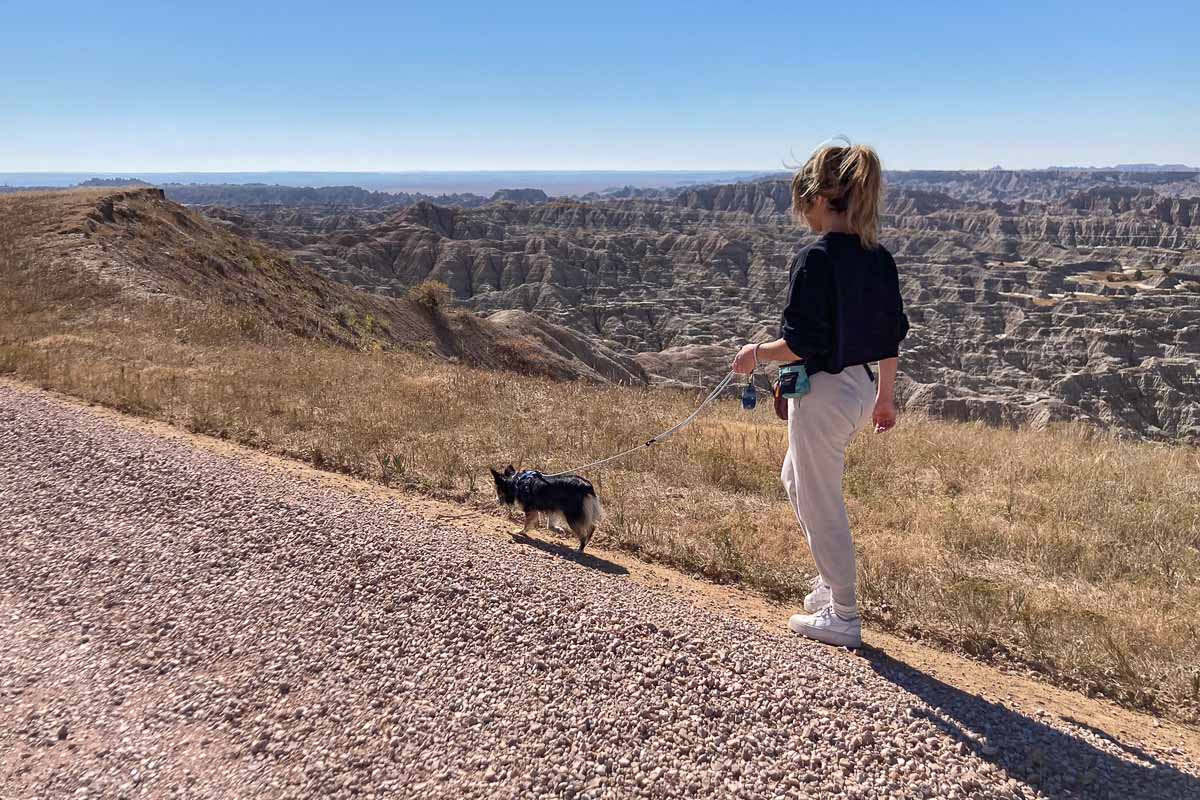
Badlands Hiking Essentials
- Carry plenty of water, even on short hikes in the Badlands. The general recommendation is to drink two quarts of water for every two hours of hiking. This is the equivalent of 32 fluid ounces or two pints.
- Wear sturdy closed-toed shoes or boots. Sturdy footwear provides better stability on uneven trails, while closed-toed shoes protect against cactus spines and rattlesnake bites.
- Wear sun protection, such as hats, sunscreen and sunglasses. There is little shade on hiking trails in Badlands National Park. Additionally, it’s a good idea to pack rain gear, too, especially in spring and summer when sudden storms are possible.
- Cell service is limited or non-existent. Don’t rely on your phone for navigation or emergencies. Bring a good map, plan your hike and, ideally, tell someone where you’re going and when you expect to be back, especially before backcountry excursions.
- Give wildlife plenty of space. As mentioned above, park rules say you must stay at least 100 feet from all wildlife. If an animal notices you when hiking in Badlands National Park, you’re too close.
10 Best Hikes in Badlands National Park
Although the Badlands Loop Road is an easy way to see the scenery, get to scenic Badlands sunrise viewing spots and watch wildlife, this national park is best explored on foot.
The following Badlands hiking trails are all amazing, each with its own characteristics, views, features, distance and level of difficulty.
Because many are so short and conveniently accessible, you can easily do several of them in a day. In two days, you could do them all (if you want).
Door Trail
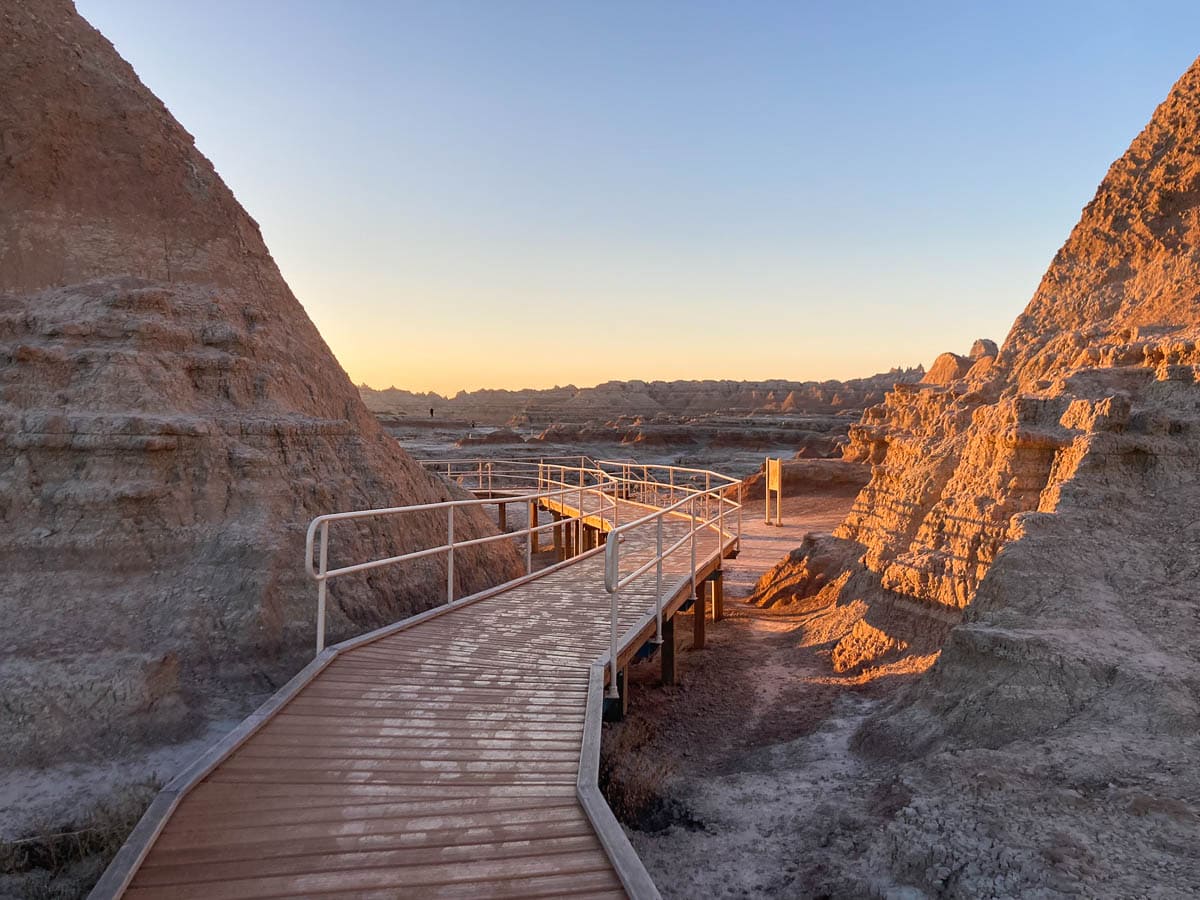
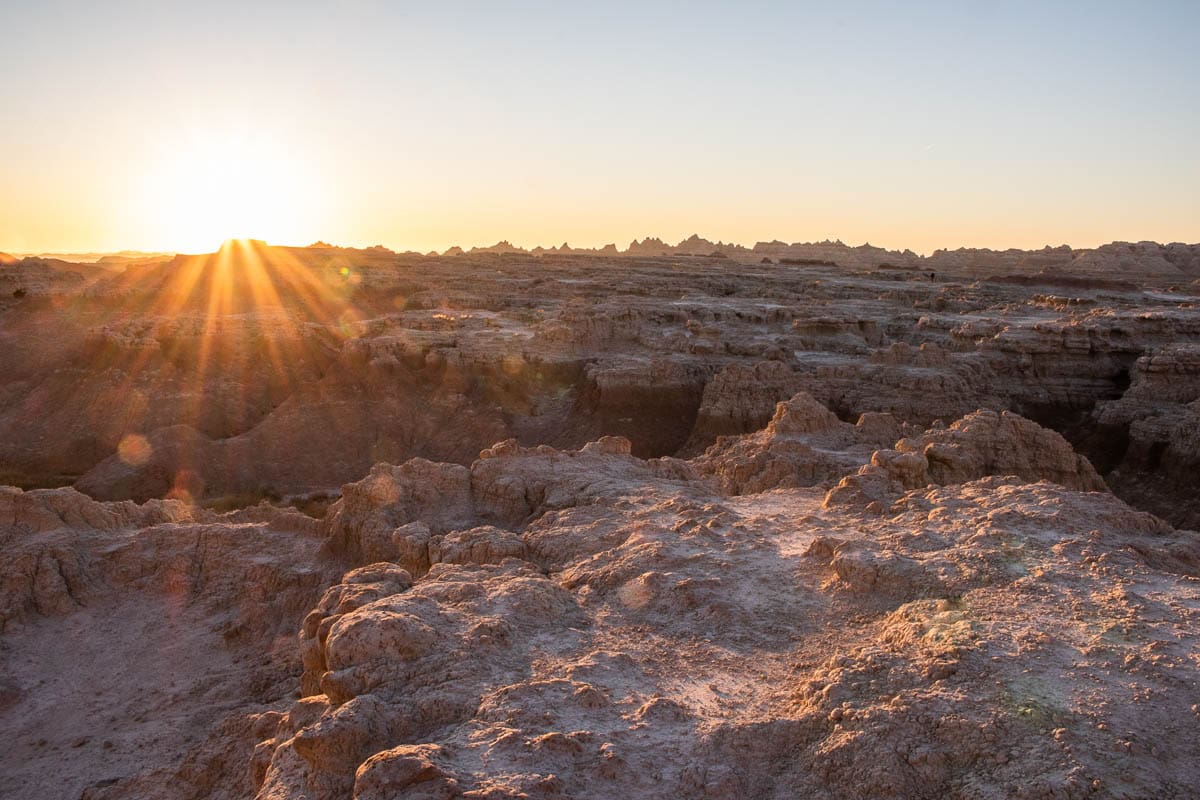
The Door Trail leads to a great view of the Badlands in the eastern portion of the park.
As the name suggests, this trail takes you to an opening in the Badlands called “the Door” via an accessible boardwalk. Beyond the boardwalk, the trail continues but is unpaved and unmaintained.
This is a great trail to immerse yourself in the ruggedness of the Badlands and is especially spectacular just after sunrise.
The roundtrip distance of the Door Trail is only 0.75 miles. Its trailhead is at the expansive Door, Window, Notch and Castle Trail parking area, a short drive south of the popular Big Badlands Overlook.
- Distance: 0.75 miles (out and back)
- Duration: 30 minutes
- Difficulty: easy
- Trailhead: Door, Window, Notch and Castle trails parking lot
- Accessible: Yes, first 1/4 mile to “the Door”
Window Trail

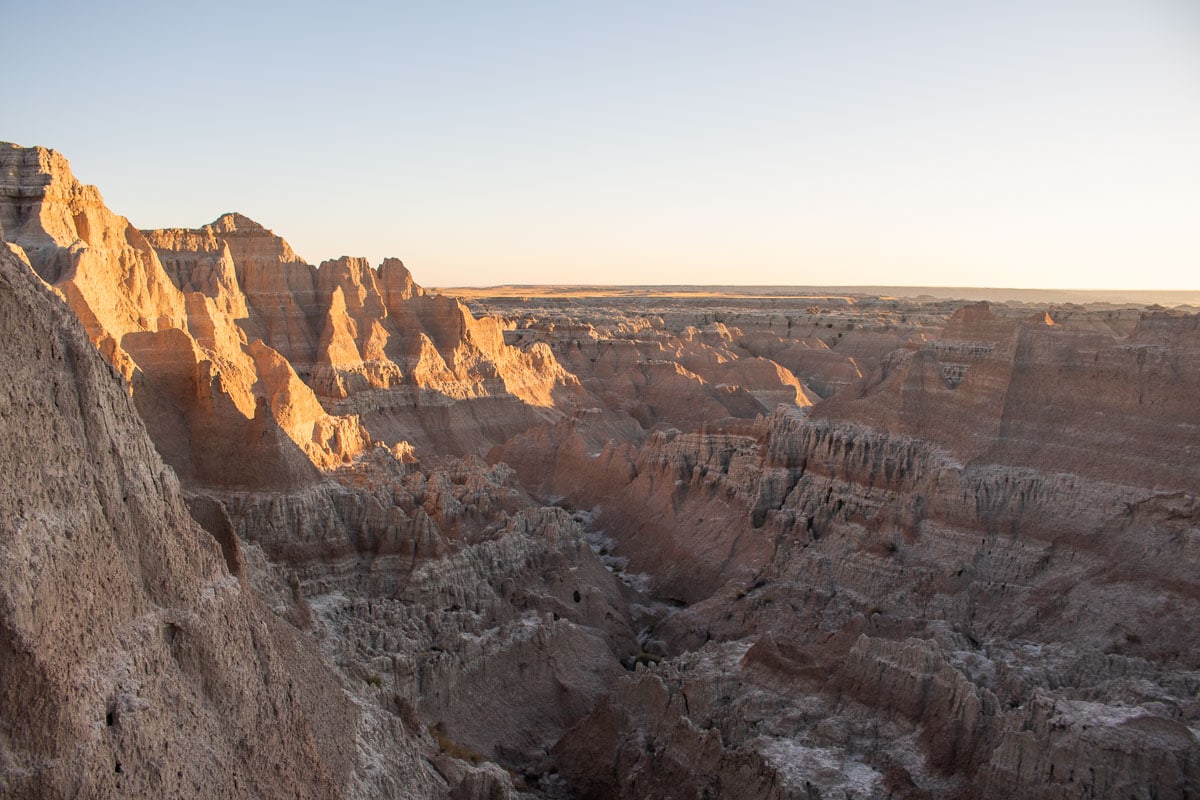
The Window Trail, located just south of the Door Trail, is even shorter, with a total roundtrip distance of 0.25 miles.
The entire hike is on a boardwalk, leading to a natural window in the Badlands Wall, which offers a view of an eroded canyon. From “the Window,” you can clearly see the famed Badlands Wall, as well as the park’s renowned rock formations.
Because this is a boardwalk, it’s a great option for people with disabilities and families with young kids.
- Distance: 0.25 miles (out and back)
- Duration: 15 minutes
- Difficulty: easy
- Trailhead: Door, Window, Notch and Castle trails parking lot
- Accessible: Yes
Notch Trail
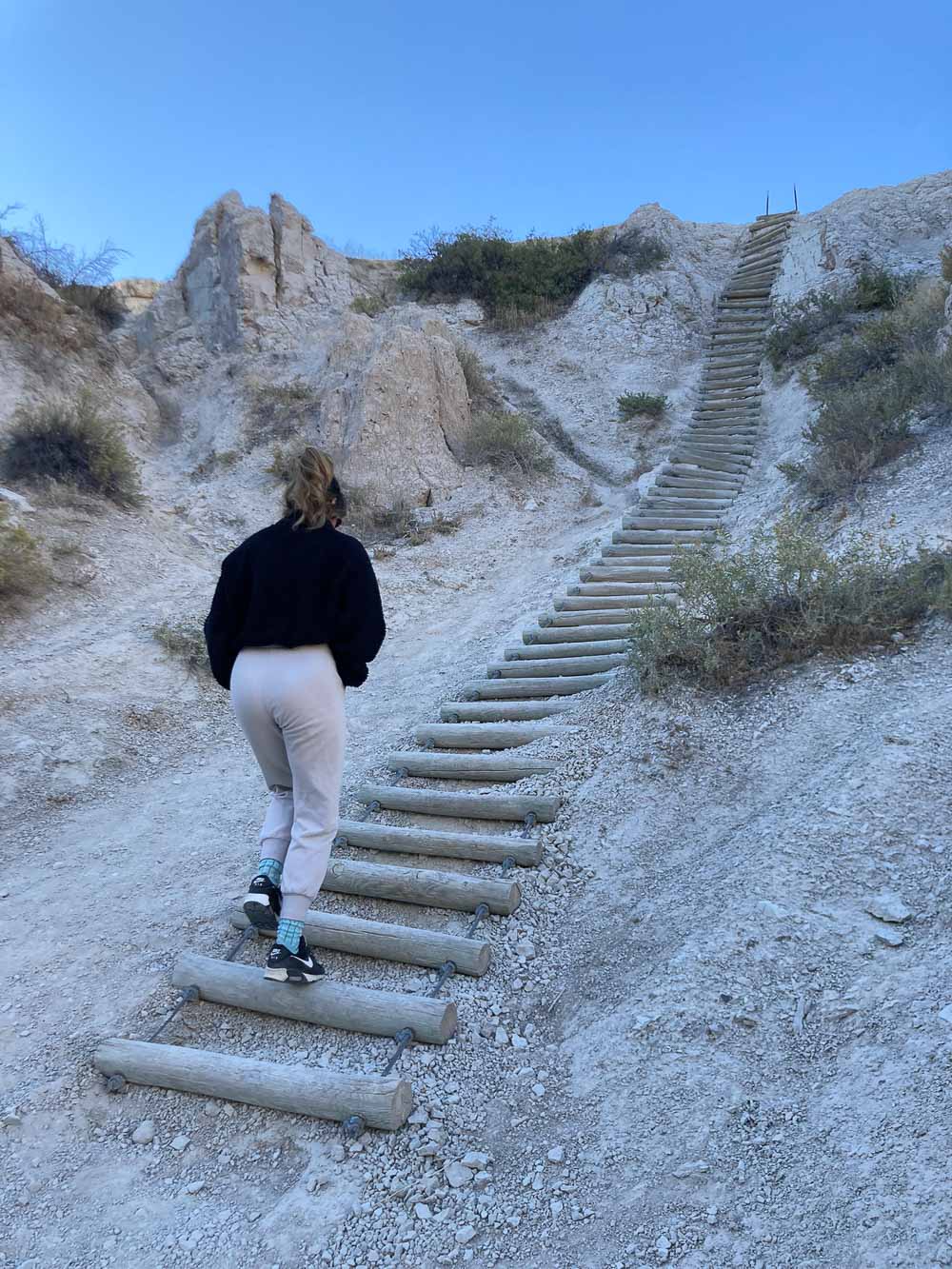
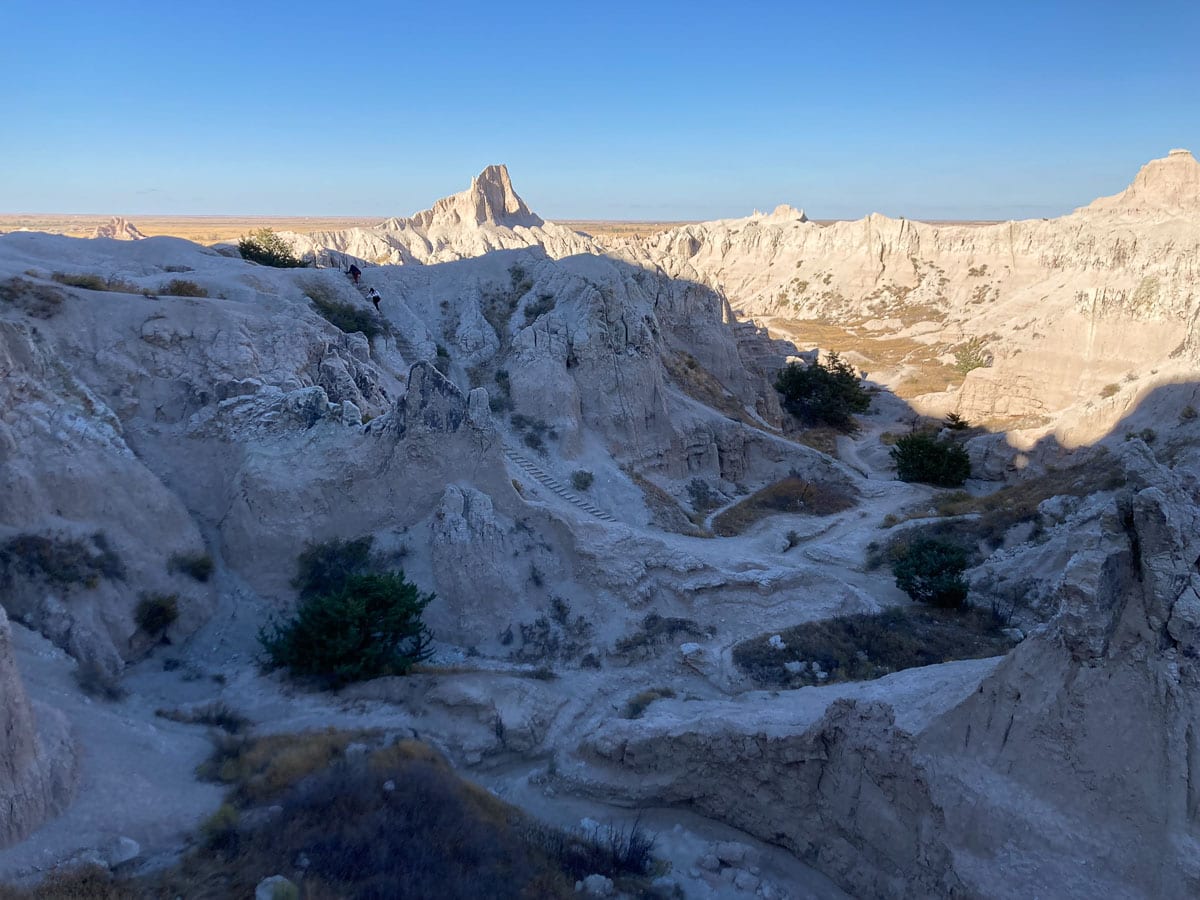
Arguably the most popular day hike in Badlands National Park, the Notch Trail combines a fun ladder climb, a walk along a cliff edge and a spectacular view. If you’re unsure about which hikes to do in the Badlands, this should definitely be one of them.
The trail starts at the south end of the Door, Window, Notch and Castle Trail parking lot, winding its way briefly through a beautiful canyon, before ascending a log ladder and continuing along a ledge.
The ultimate destination is “the Notch,” where a dramatic, panoramic view of the White River Valley awaits.
This is one of the most fun hikes in Badlands National Park, but the Park Service reminds hikers to be careful on cliff edges. Additionally, the trail is usually quite slippery during and after rainstorms—think twice before doing this hike in those circumstances.
- Distance: 1.5 miles (out and back)
- Duration: 45-60 minutes
- Difficulty: moderate (with steep ladder climb)
- Trailhead: Door, Window, Notch and Castle trails parking lot
- Accessible: No
Cliff Shelf Nature Trail
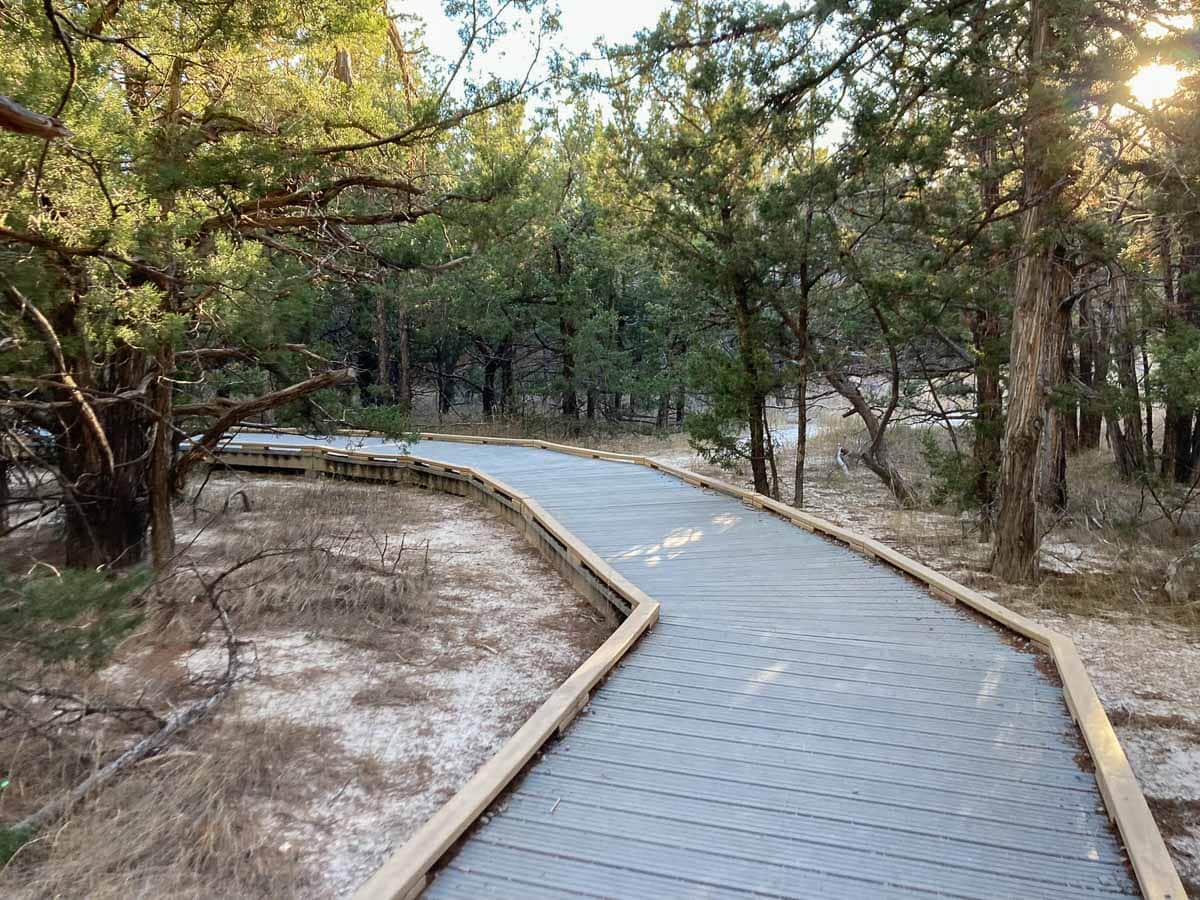
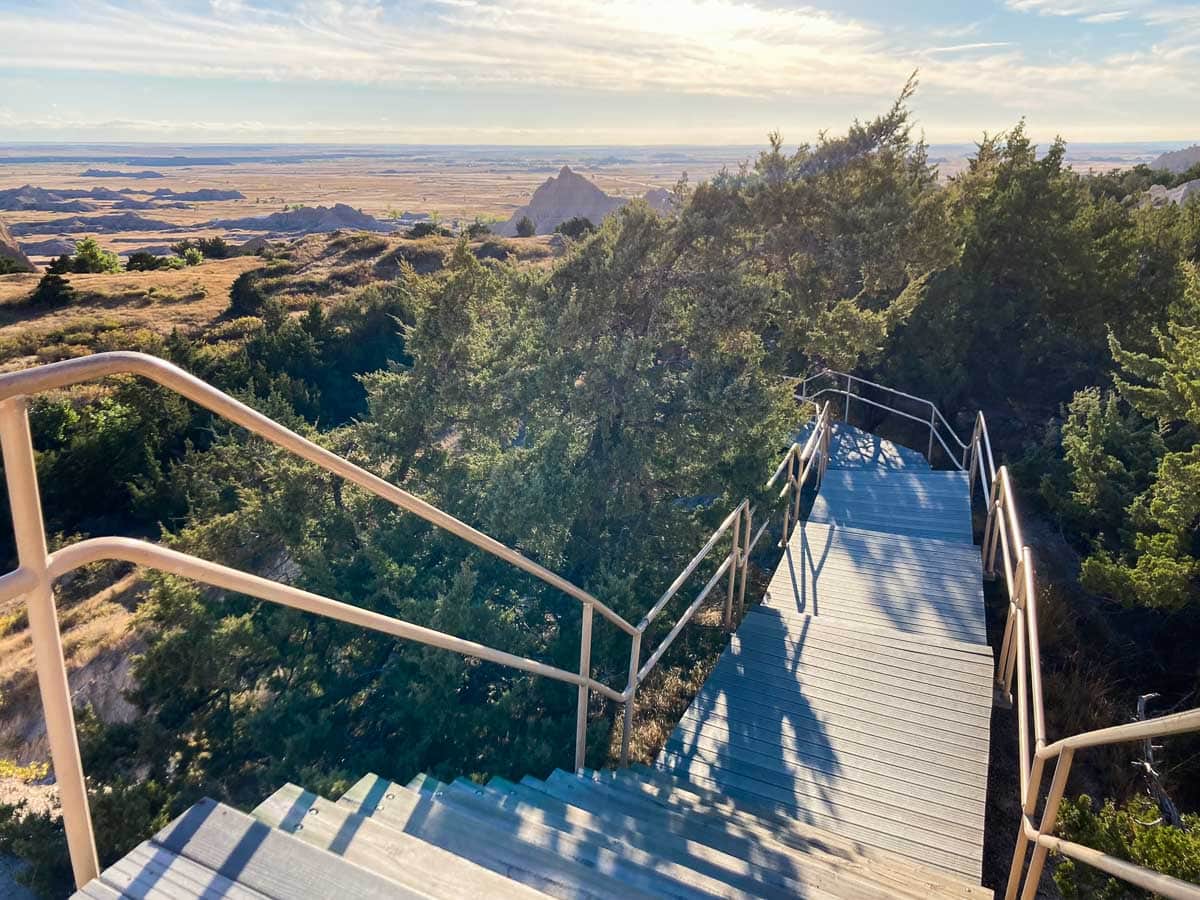
A fascinating loop hike just above Cedar Pass, the Cliff Shelf Nature Trail circles through and around an oasis in the Badlands.
This is one of only a few forested areas in the national park, a stand of juniper trees near an occasional pond. Thanks to those trees, this is also the only hike in the park with significant shade.
When there’s water in the pond after rainfall, this is a great spot to see wildlife like mule deer and bighorn sheep.
The trail itself is a combination of pavement, boardwalks and steps. It climbs about 200 vertical feet to a boardwalk viewpoint above the forest. Enjoy an amazing vista of the White River Valley and don’t forget to look behind you—you might see some people up at “the Notch” above.
- Distance: 0.5 miles (loop)
- Duration: 20-30 minutes
- Difficulty: moderate
- Trailhead: Cliff Shelf parking lot
- Accessible: No
Saddle Pass Trail
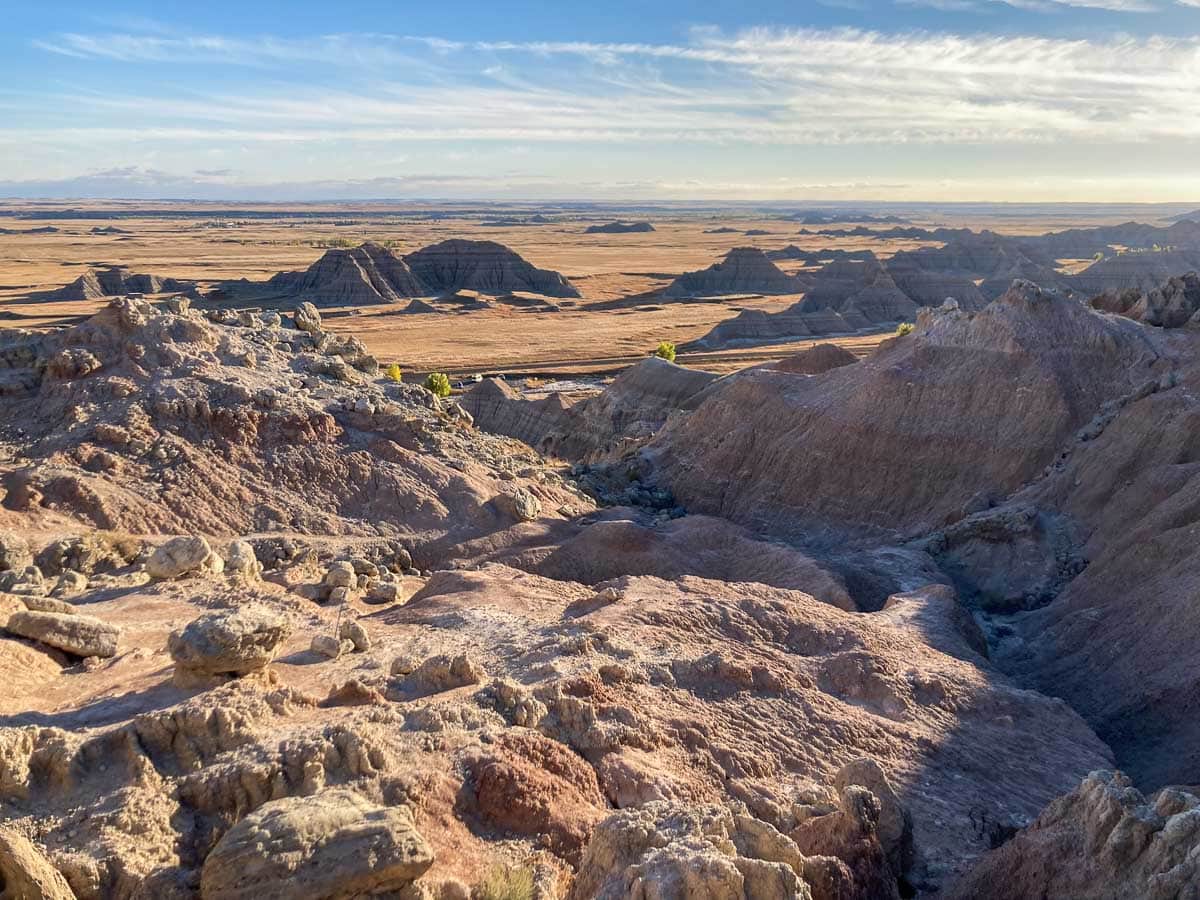
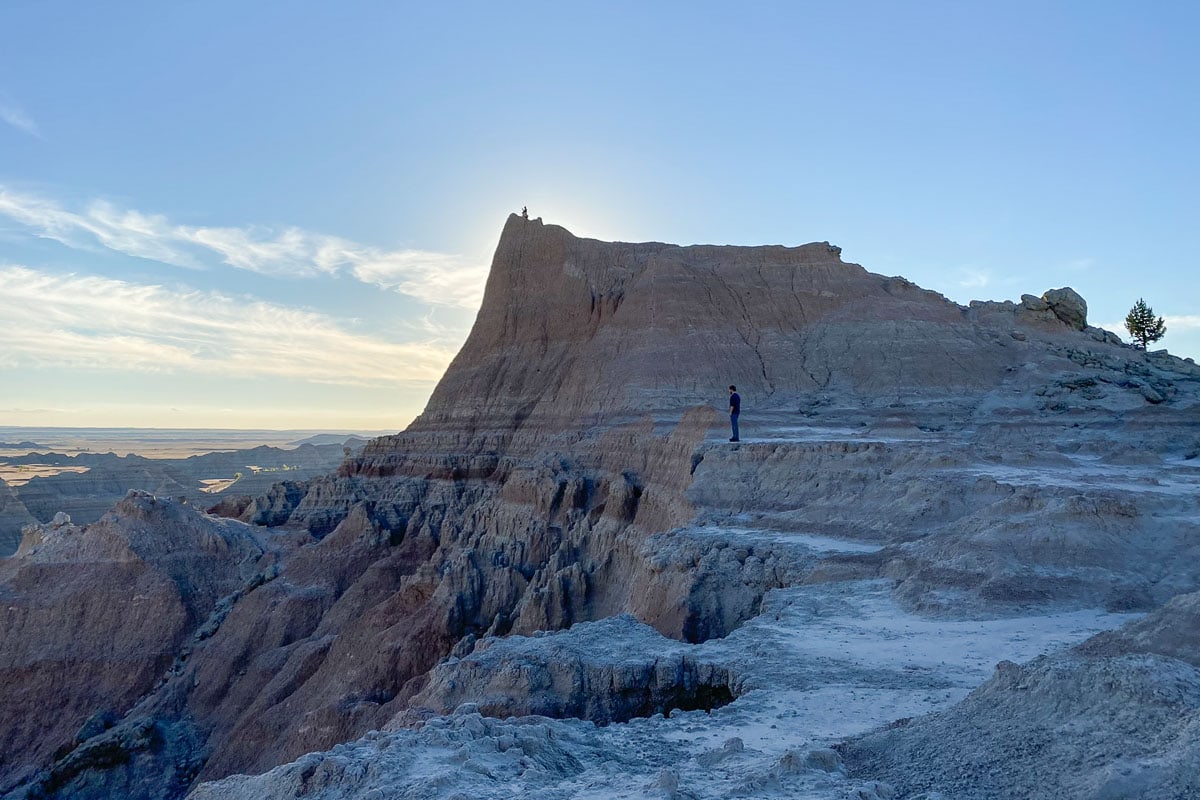
Without question the steepest trail in Badlands National Park, the Saddle Pass Trail climbs quickly from the Badlands Loop Road up to the top of the Badlands Wall.
The total elevation gain is approximately 300 feet, much of which is on a rather short, exceptionally steep section. Much of the trail surface is loose gravel, which makes it quite slippery in certain areas.
Once up on Saddle Pass, you can enjoy breathtaking views of the Badlands and the White River Valley below. The ledge offers amazing photo ops, while you can also explore the upper Badlands area further on the connecting Castle and Medicine Root Trails.
- Distance: 0.7 miles (out and back)
- Duration: 30-45 minutes
- Difficulty: strenuous
- Trailhead: Saddle Pass Trailhead
- Accessible: No
Fossil Exhibit Trail
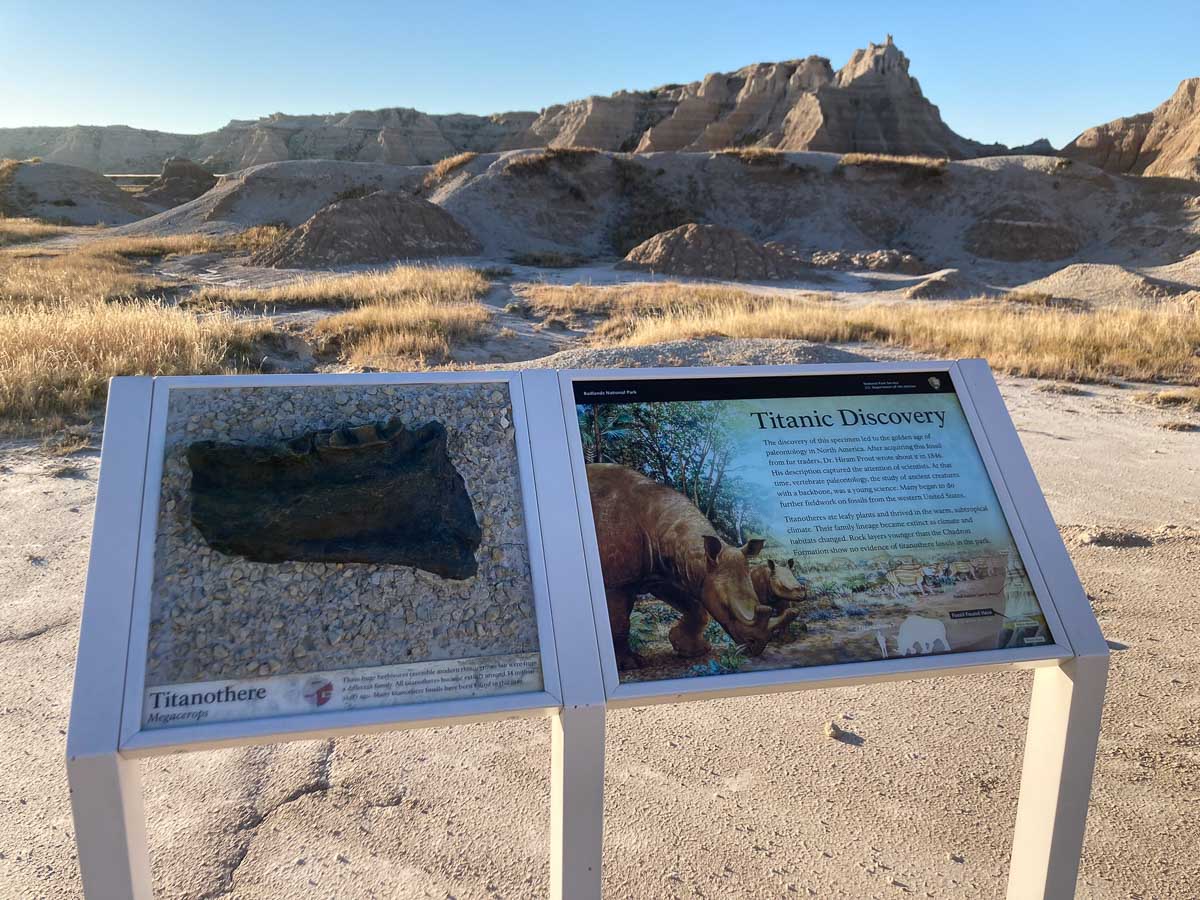

This is one of the Badlands National Park hikes you shouldn’t skip. Even if you’re not into paleontology or general history, walking this short boardwalk does give you a better insight into what this national park is about.
As its name suggests, the Fossil Exhibit Trail runs past a number of exhibits of fossil replicas. You can learn about the ancient animals that once lived in this region—the White River Badlands are home to one of the world’s richest mammal fossil beds.
Walk this easy, wheelchair-accessible trail and learn about extinct animals like sabertoothed cats, the ancestors of modern-day horses and Titanotheres.
- Distance: 0.25 miles (loop)
- Duration: 15 minutes
- Difficulty: easy
- Trailhead: Fossil Exhibit Trail parking lot
- Accessible: Yes
Find more national parks and monuments with dinosaurs and other fossils here!
Castle Trail – Medicine Root Trail Loop
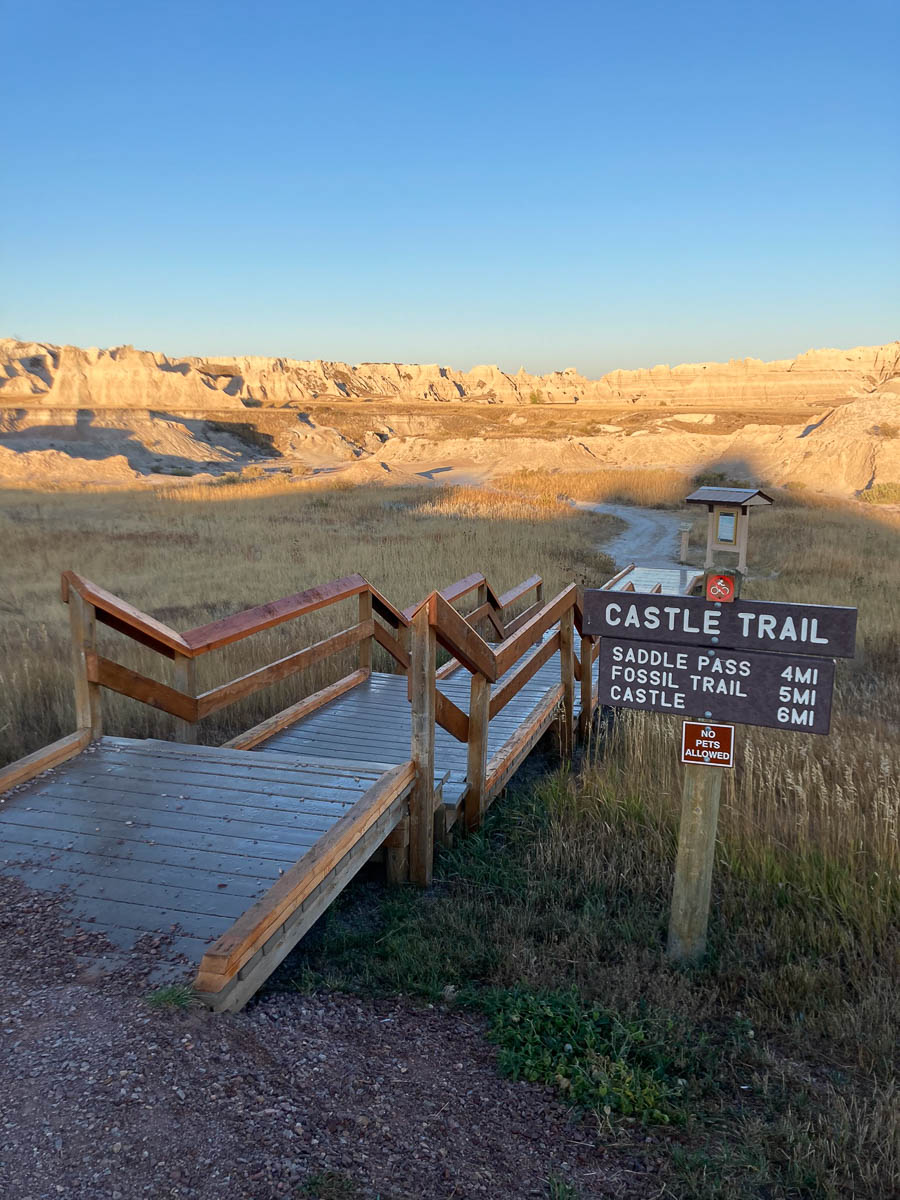

A combination of two of the longest trails in Badlands National Park, the Castle Trail – Medicine Root Trail Loop explores the mixed-grass prairie of the park, as well as offers wonderful views of the Badlands formations.
This loop is about 4 miles long, slightly more when taking into account the access trails.
You can get to the loop via the Castle Trail from the Door, Window and Notch Trails parking lot or from the Castle Trailhead at Fossil Exhibit. The Saddle Pass Trail offers the shortest, yet steepest, access path to the loop.
A relatively level and moderate hike, this is a great option for visitors looking for a longer and varied hike in the Badlands.
- Distance: 4+ miles (lollipop)
- Duration: 2-4 hours
- Difficulty: moderate
- Trailhead: Door, Window, Notch and Castle trails parking lot, Saddle Pass Trailhead, or across the road from the Fossil Exhibit Trail
- Accessible: No
Deer Haven Game Trails
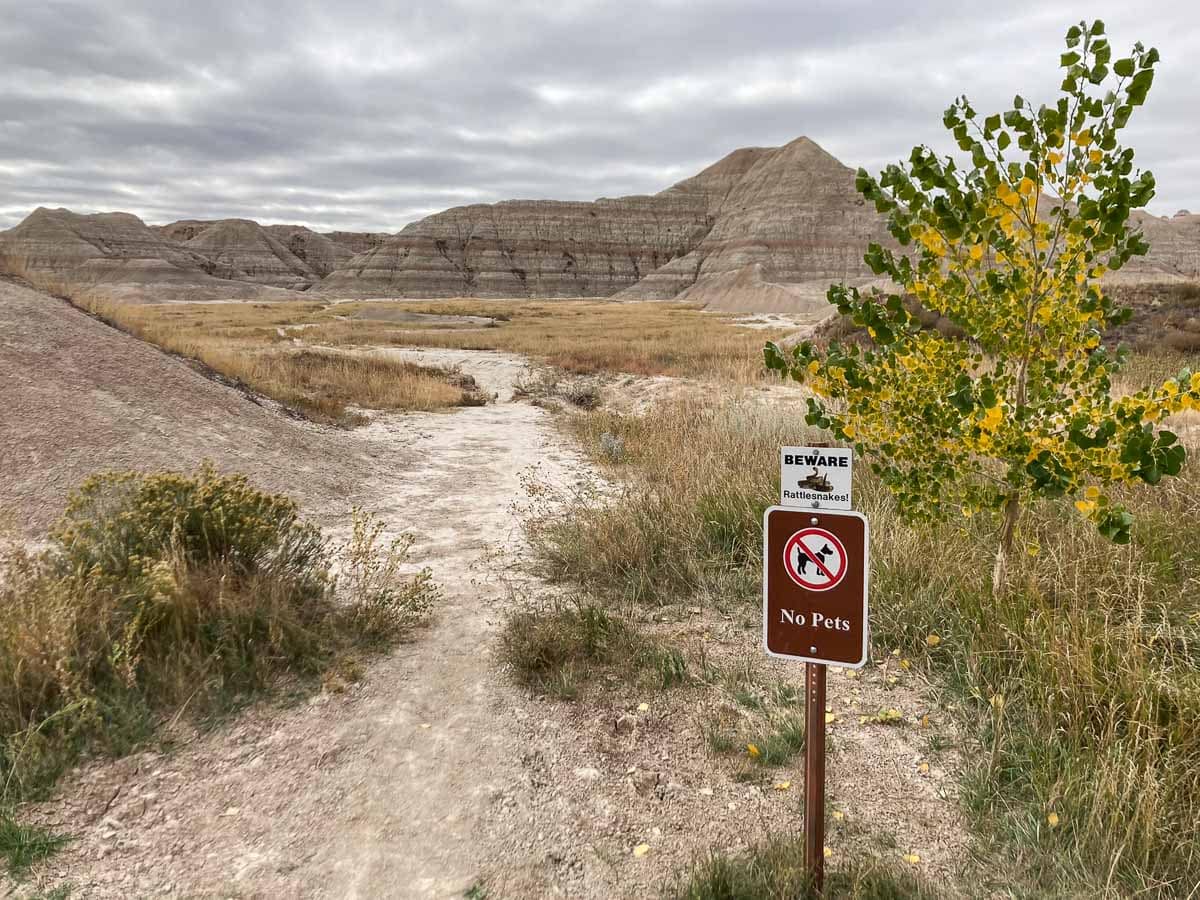
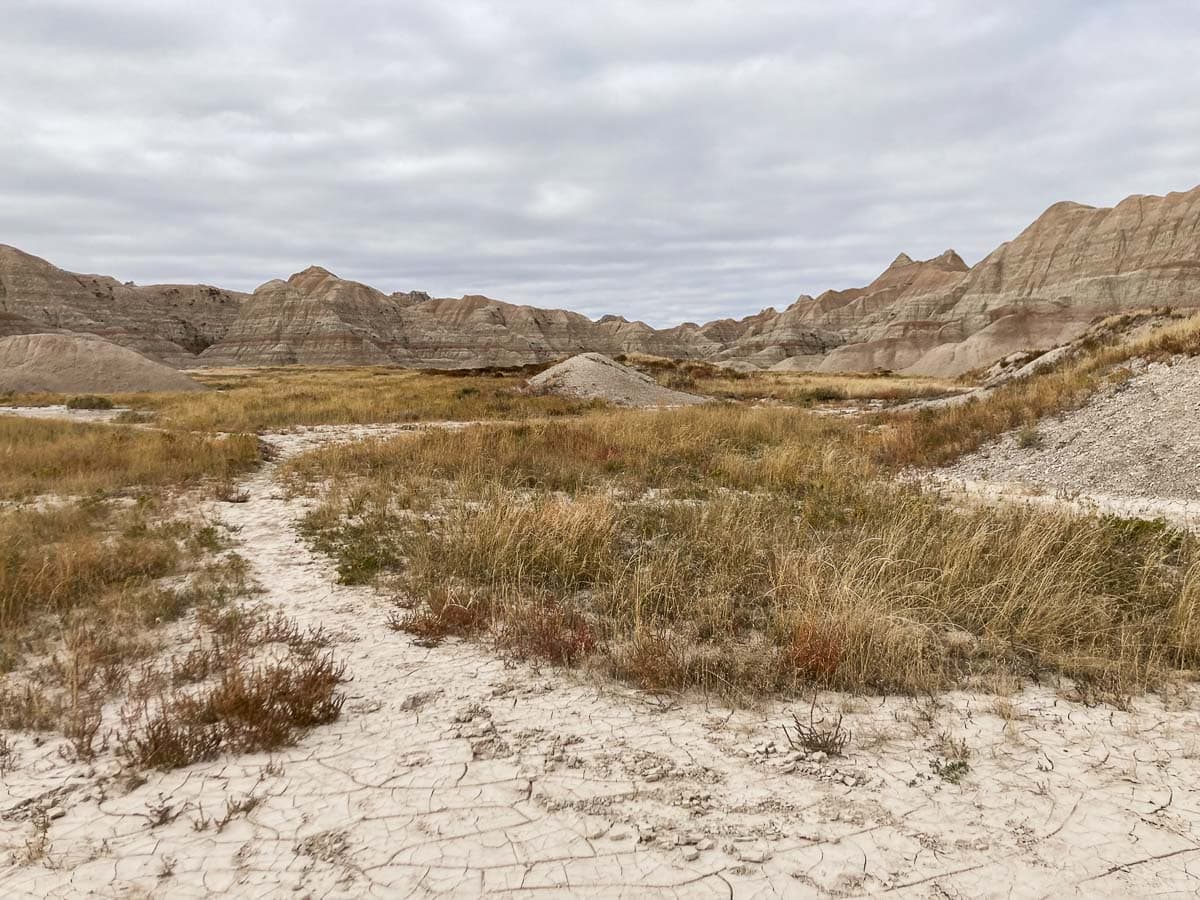
The open hike policy of Badlands National Park makes it possible to follow game trails into the wilderness. You can do this anywhere in the park, but one of the most popular areas is known as Deer Haven.
The Deer Haven Trail is an unofficial and unmaintained network of game trails in the heart of the park’s North Unit. It starts at the far end of the Conata Picnic Area—make sure to fill out the backcountry registration form before starting your hike.
Deer Haven, after which the trail is named, is about 3 miles from the trailhead, a small stand of juniper trees where wildlife is often spotted.
You can continue following the game trails deeper into the wilderness or retrace your steps to the trailhead at the picnic area.
- Distance: various, the Badlands open hike policy allows for unlimited exploration
- Duration: various
- Difficulty: easy to strenuous
- Trailheads: Conata Picnic Area
- Accessible: No
Sage Creek Wilderness
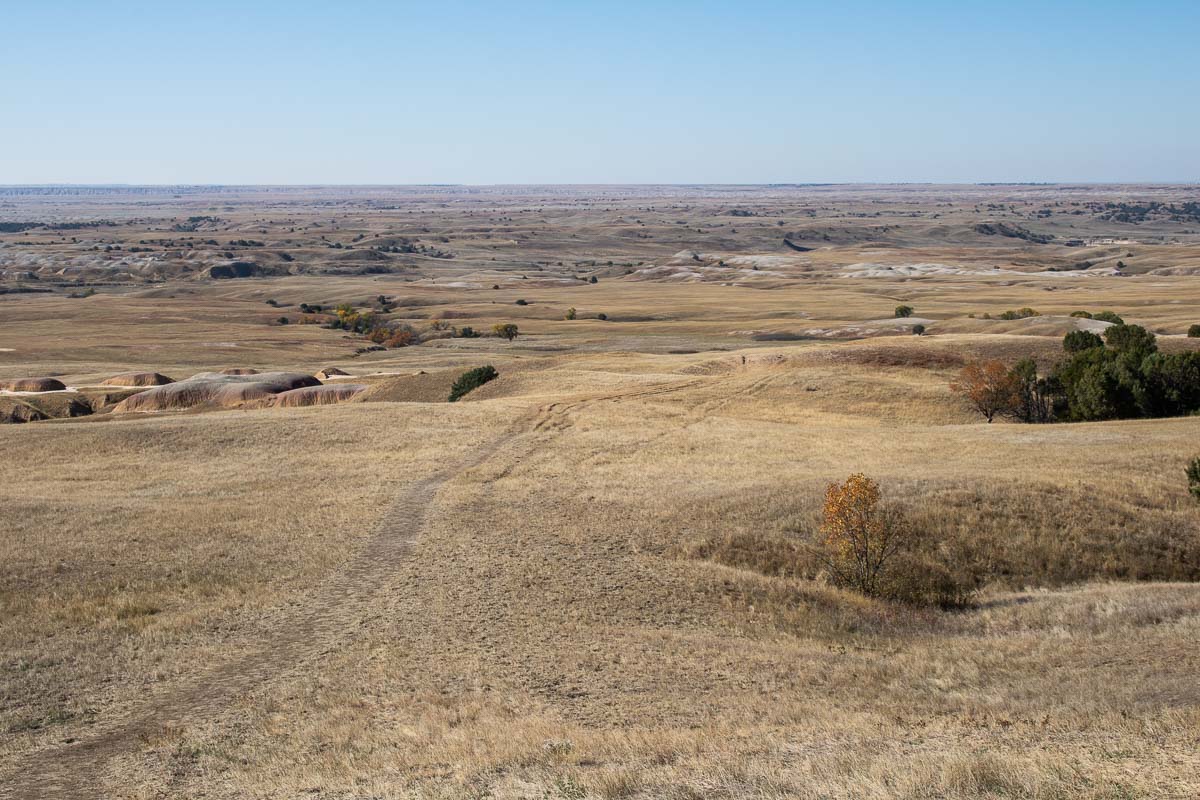
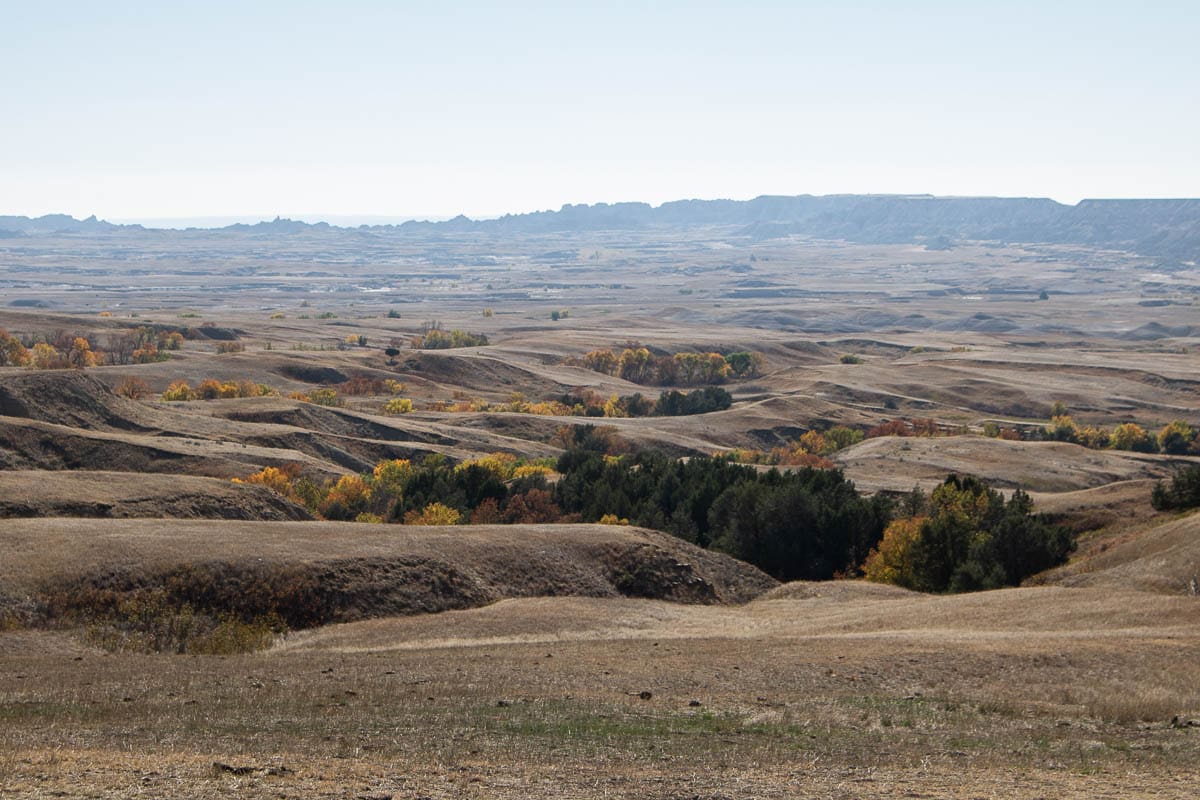
A sprawling region of rolling grasslands and small buttes, the Sage Creek Wilderness occupies most of the northwest of the North Unit.
The unpaved Sage Creek Rim Road runs along its northern edge, offering superb views of and access to the wilderness.
You can enter the Sage Creek Wilderness from various locations along the road, but the best ones are the Sage Creek Campground and the Sage Creek Basin Overlook. Again, make sure to enter your information in the backcountry register before your hike.
This area is different from other places in Badlands National Park, in the sense that it consists of mostly eroded-away Badlands. The Cretaceous sediments below the Badlands rock layers are “more suitable for soil development for the grasslands,” according to the National Park Service.
As such, prairie grasslands dominate this area, crisscrossed by bison trails. You can clearly see these game trails from the road and you’re free to explore the wilderness on these trails.
Keep an eye out for bison and other wildlife, though. Many animal species, some dangerous, live in the Sage Creek Wilderness.
- Distance: various, the Badlands open hike policy allows for unlimited exploration
- Duration: various
- Difficulty: easy to strenuous
- Trailhead: Sage Creek Basin Overlook or Sage Creek Campground
- Accessible: No
Badlands Wilderness Overlook – Hay Butte Overlook Walk
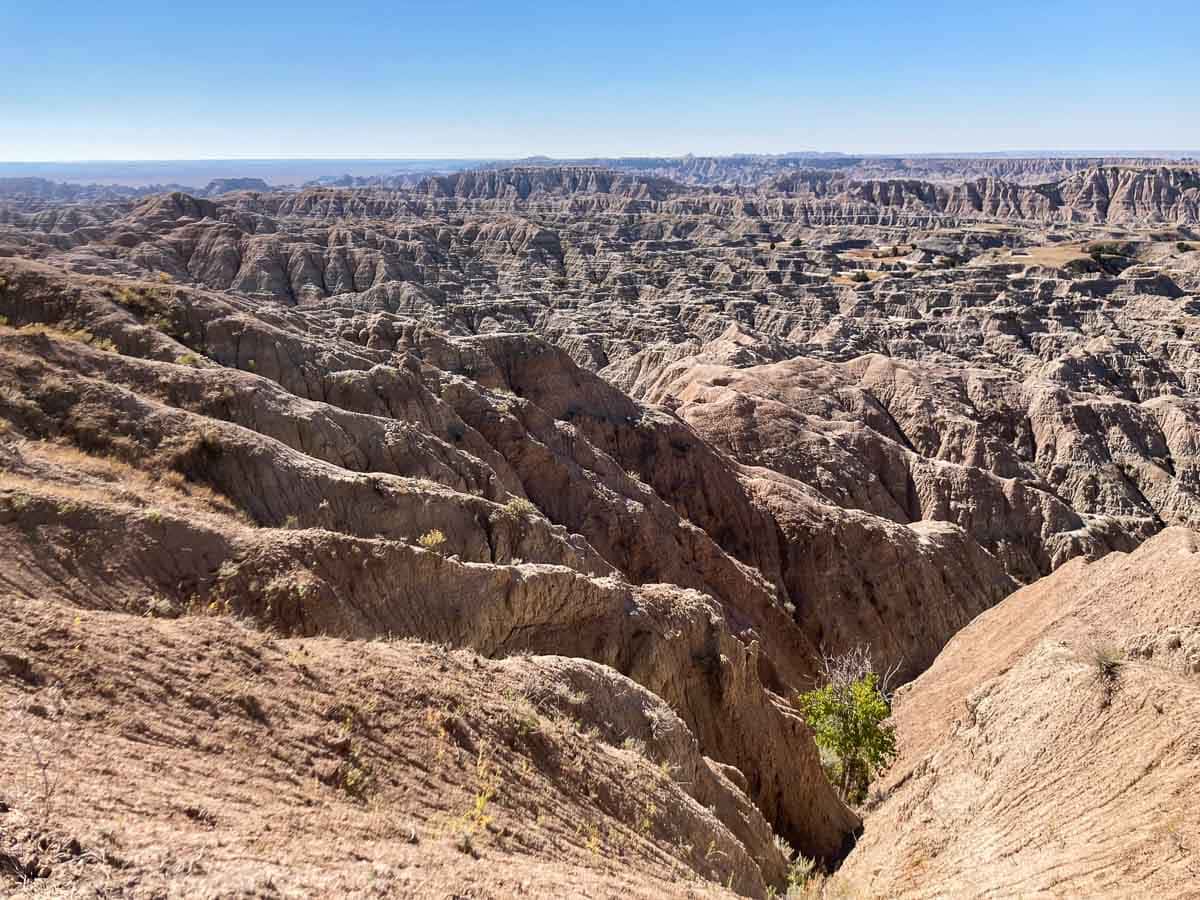
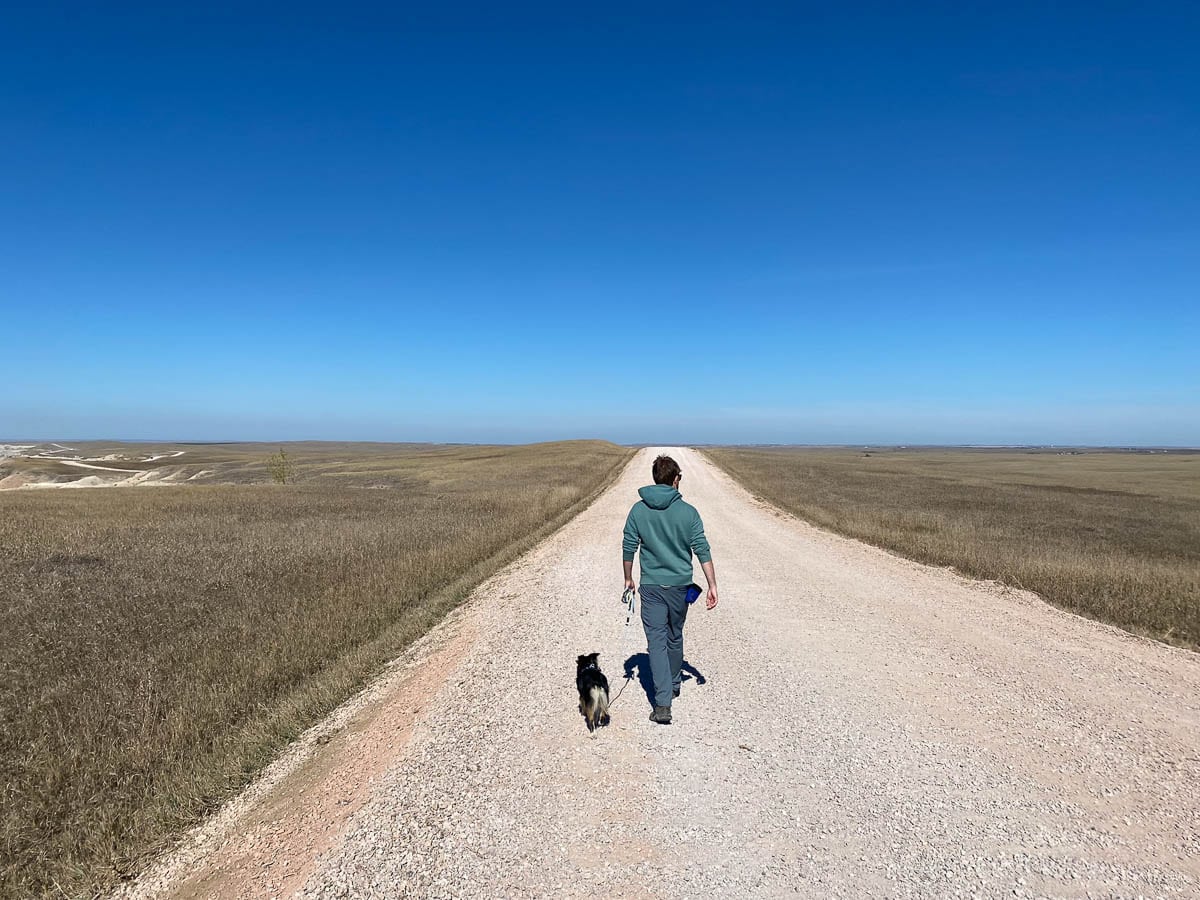
Although it’s not an official hiking trail in Badlands National Park, I strongly recommend doing this beautiful hike.
The walk between the Badlands Wilderness Overlook and Hay Butte Overlook on the Sage Creek Rim Road is fantastic. It’s a wonderful way to experience this gravel road, enjoy the views from a different perspective and maybe even spot some wildlife in the distance. (Watch for bison on the road, though!)
The distance between the two overlooks, both of which offer spectacular views, is only 0.6 miles one-way. There’s a slight incline, but nothing too difficult.
Additionally, this is also a great walk to do if you’re visiting Badlands National Park with your dog!
- Distance: 1.2 miles (out and back)
- Duration: 30-40 minutes
- Difficulty: easy
- Trailhead: Badlands Wilderness Overlook or Hay Butte Overlook
- Accessible: No

